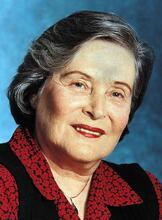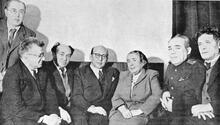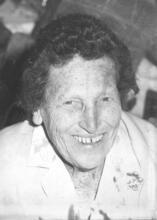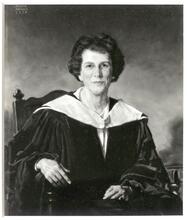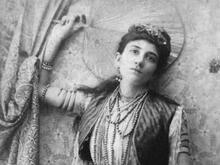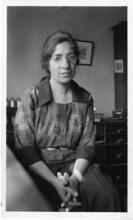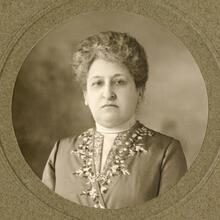Bertha Kaplan Spector
Born in Russia, Bertha Kaplan Spector nearly didn’t finish high school due to lack of funds, but she went on to receive three degrees from the University of Chicago. For over a decade, Spector published extensively on amebic dysentery. Soon after she married Morris Spector, Spector joined the research staff of the University of Chicago Department of Medicine. In 1933, the Century of Progress World’s Fair came to Chicago, bringing with it the only known large-scale epidemic of amebic dysentery in a civilian population until that time. Spector’s extensive research was utilized, saving lives, instructing physicians, and leading to more stringent sanitation standards. Her research brought her to Native American reservations in New Mexico in 1936. She died the age of forty-one, of Hodgkin’s disease.
Bertha Kaplan Spector was a bacteriologist whose authoritative research helped to control an epidemic of amebic dysentery during the Chicago Century of Progress World’s Fair. Her work contributed to a better understanding of the disease, as well as to new standards of hygiene.
Early Life & Education
Born on October 9, 1896, in Kobrin, Russia, Bertha Kaplan Spector was one of eight children of Samuel and Rose (Hausman) Kaplan. In 1905, her family moved to Chicago, where her high school education almost ended for lack of money until a family friend found her a job. She received three degrees from the University of Chicago: a B.S. (1916), an M.S. (1921), and a Ph.D. (1931) in hygiene and bacteriology.
Research Positions
Bertha was a research assistant with the Bussey Institute at Harvard University from 1916 to 1918. During World War I, she worked as a bacteriologist at the U.S. Base Hospital at Fort Riley, Kansas, from 1918 to 1919. After the war, she went to work in Chicago as a bacteriologist in the U.S. Veterans Hospital from 1921 to 1923 and Cook County Hospital from 1923 to 1926, contributing to several medical journal articles on streptococcal hemolytic toxins.
She concentrated her research on the study of amebic dysentery as an instructor in bacteriology and parasitology at the University of Illinois College of Medicine from 1926 to 1929. She spent 1928 at the Institut für Schiff und Tropen Krankheiten in Hamburg, Germany. In 1929, the University of Illinois awarded her the Beaumont Prize for her research on the gastrointestinal tract. Over the next decade, she published extensively on amebic dysentery.
She and Morris Spector, a patent attorney, were married on March 8, 1929. They had two children: Rosa Leah (b. 1930), and Avron Newton (b. 1933). Soon after she married, Spector joined the research staff of the University of Chicago Department of Medicine, Douglas Smith Foundation. She also became a member of Hadassah.
World’s Fair Dysentery Outbreak
In 1933, the Century of Progress World’s Fair came to Chicago, along with over eight million people. It brought with it the only known large-scale epidemic of amebic dysentery in a civilian population until that time. Poor sanitation conditions were noted as a cause of the outbreak, which involved over fourteen hundred cases and resulted in as many as 98 deaths. Physicians, who were unfamiliar with the unusual presentation of the disease, did not properly diagnose or treat it, contributing to the high fatality rate. During the outbreak, the results of years of research by Spector and her colleagues moved from the pages of medical journals to a central position in saving lives, instructing physicians, and more stringent sanitation standards.
Spector’s precautions against water contamination are part of family lore. During her investigative work on the epidemic, she lunched on hard-boiled eggs and boiled water, and did not contract amebic dysentery, as did many coworkers. Whenever utility pipe repairs were made on the street near her home, Spector would admonish her family to “boil the water!”
Final Years
Following the epidemic, Spector continued her research with the University of Chicago. In 1934, she also joined the U.S. Public Health Service as a protozoologist in charge of research work on amoebas. Her work for the government took her family to Albuquerque, New Mexico, in the summers of 1936 and 1937, where she studied dysentery in children on Indian reservations. During the summer of 1937, Spector became disabled from Hodgkin’s disease, which she diagnosed herself in 1935. She succumbed to the disease and died on March 26, 1938, at age forty-one.
Spector’s short life was a remarkable journey from a (Yiddish) Small-town Jewish community in Eastern Europe.shtetl in Russia to the laboratories of the University of Chicago, where she made important contributions to the study of amebic dysentery and became a highly regarded diagnostician. She was a devoted mother who left a legacy of caring to her children and to future generations. Bertha Kaplan Spector was buried near her mother, along with members of K’helas Jacob Anshe Drohitzin, a congregation of immigrants from near her place of birth in Russia.
AJYB 40, 1938–1939: 392.
BEOAJ.
Cutler, Irving. The Jews of Chicago from Shtetl to Suburb. Urbana and Chicago: University of Illinois Press, 1996.
Geiger, J.C., C.S. Williamson, and B. Kaplan. “The Advance against Amebic Dysentery.” In Chemistry in Medicine: A Cooperative Treatise Intended to Give Examples of Progress Made in Medicine with the Aid of Chemistry, edited by Julius Stieglitz. New York: Chemical Foundation, 1928.
Kirsner, Joseph B., M.D., Ph.D., Louis Block Distinguished Service Professor of Medicine, University of Chicago Medical Center. Interview by author, November 1996.
Marcus, Jacob Rader. The American Jewish Woman, 1654–1980, 1981.
Minsk, Rosalie [daughter]. Interview by author, January 1997.
Obituary. Chicago Tribune, March 27, 1938.
Obituary. New York Times, March 27, 1938, II 6:6.
Spector, Avron Newton. Interview by author, December 1996.
Spector, B. K. “Amebiasis in Chicago, December 1933 to June 1936.” In American Journal of Public Health 27, July 1937: 694–700.

